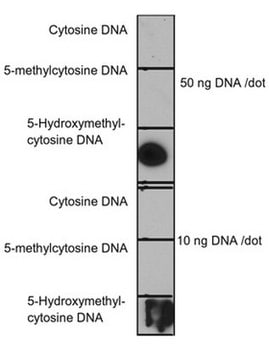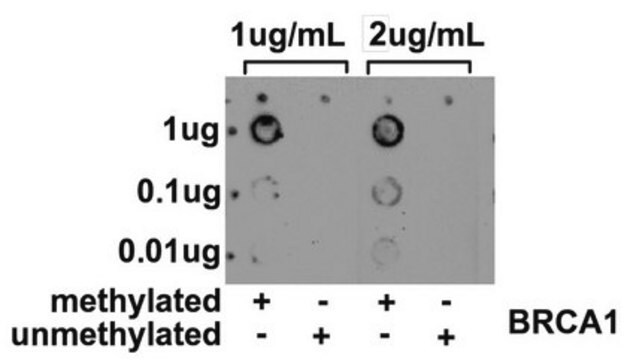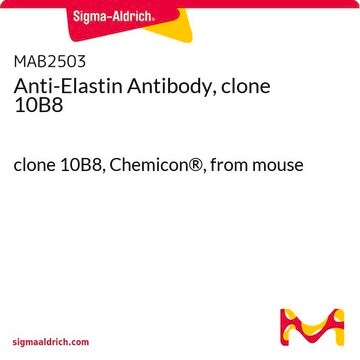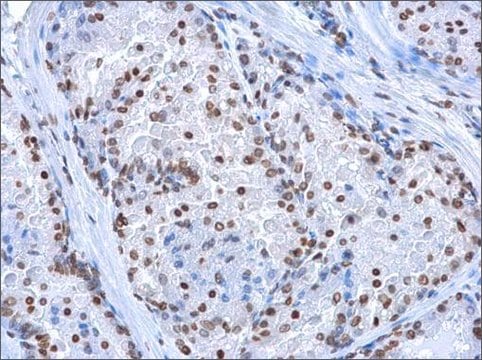推荐产品
生物源
mouse
品質等級
抗體表格
purified immunoglobulin
抗體產品種類
primary antibodies
無性繁殖
HMC 31, monoclonal
物種活性(以同源性預測)
all
技術
ELISA: suitable
dot blot: suitable
methylated DNA immunoprecipitation (MeDIP): suitable
同型
IgG1κ
運輸包裝
wet ice
目標翻譯後修改
unmodified
一般說明
5-Hydroxymethylcytosine is a DNA pyrimidine nitrogen base formed from the enzymatic conversion of 5-methylcytosine into 5-hydroxymethylcytosine by the TET family of iron-dependent oxygenases. Data suggests that every mammilian cell contains 5-hydroxymethylcytosine, but the levels vary depending on the cell type; data also suggests that levels of 5-hydroxymethylcytosine increases with age. The highest levels are found in neuronal cells of the central nervous system and certain mammalian tissues such as mouse Purkinje and granule neurons. Although the exact function has not been fully elucidated, studies suggest that 5-hydroxymethlcytosine may regulate gene expression or initiate DNA demethylation.
特異性
This antibody recognizes the 5-hydroxymethylcytosine of 5-Hydroxymethylcytosine DNA.
免疫原
BSA-conjugated 5-hydroxymethylcytosine.
Epitope: 5-hydroxymethylcytosine
應用
Detect 5-hydroxymethylcytosine (5hmC) with Anti-5-hydroxymethylcytosine (5hmC) Antibody, clone HMC 31 (Mouse Monoclonal Antibody), that has been shown to work in DB, MeDIP, ELISA.
ELISA Analysis: A representative lot detected 5-hydroxymethylcytosine in ELISA.
Methylated DNA Immunoprecipitation (MeDIP) Analysis: A representative lot immunoprecipitated 5-hydroxymethylcytosine in ChIP.
Methylated DNA Immunoprecipitation (MeDIP) Analysis: A representative lot immunoprecipitated 5-hydroxymethylcytosine in ChIP.
Research Category
Epigenetics & Nuclear Function
Epigenetics & Nuclear Function
Research Sub Category
Chromatin Biology
Chromatin Biology
品質
Evaluated by Dot Blot in unmodified and modified cytosine DNA.
Dot Blot Analysis: 0.1 µg/mL of this antibody detected 5-hydroxymethylcytosine in 10 ng and 50 ng of unmodified and modified cytosine DNA.
Dot Blot Analysis: 0.1 µg/mL of this antibody detected 5-hydroxymethylcytosine in 10 ng and 50 ng of unmodified and modified cytosine DNA.
標靶描述
This antibody detects 5-hydroxymethylcytosine.
外觀
Protein G Purified
Format: Purified
Purified mouse monoclonal IgG1κ in buffer containing 0.1 M Tris-Glycine (pH 7.4), 150 mM NaCl with 0.05% sodium azide.
儲存和穩定性
Stable for 1 year at 2-8°C from date of receipt.
分析報告
Control
Unmodified and modified cytosine DNA.
Unmodified and modified cytosine DNA.
其他說明
Concentration: Please refer to the Certificate of Analysis for the lot-specific concentration.
免責聲明
Unless otherwise stated in our catalog or other company documentation accompanying the product(s), our products are intended for research use only and are not to be used for any other purpose, which includes but is not limited to, unauthorized commercial uses, in vitro diagnostic uses, ex vivo or in vivo therapeutic uses or any type of consumption or application to humans or animals.
Not finding the right product?
Try our 产品选型工具.
儲存類別代碼
12 - Non Combustible Liquids
水污染物質分類(WGK)
WGK 1
閃點(°F)
Not applicable
閃點(°C)
Not applicable
Tet methylcytosine dioxygenase 1 promotes hypoxic gene induction and cell migration in colon cancer.
Ling Ma et al.
Journal of cellular physiology, 234(5), 6286-6297 (2018-10-28)
Ten-eleven translocation 1 (TET1), a widely reported DNA demethylation protein, has been associated with tumorigenesis and metastasis. However, whether TET1 is an oncogene or tumor suppressor gene has been controversial; the mechanism of how TET1 affects cancer progression remains unclear.
Ling Ma et al.
Journal of cellular physiology, 235(10), 6711-6724 (2020-01-30)
Hypermethylation of gene promoter has been indicated for the contribution of gene silencing, and DNA demethylating drugs, such as 5-aza-2'-deoxycytidine (DAC), has been used clinically for cancer treatment. However, the reason why a proportion of genes with hypermethylated promoter exhibit
ERK1/2-EGR1-SRSF10 Axis Mediated Alternative Splicing Plays a Critical Role in Head and Neck Cancer.
Sandhya Yadav et al.
Frontiers in cell and developmental biology, 9, 713661-713661 (2021-10-08)
Aberrant alternative splicing is recognized to promote cancer pathogenesis, but the underlying mechanism is yet to be clear. Here, in this study, we report the frequent upregulation of SRSF10 (serine and arginine-rich splicing factor 10), a member of an expanded
我们的科学家团队拥有各种研究领域经验,包括生命科学、材料科学、化学合成、色谱、分析及许多其他领域.
联系技术服务部门








